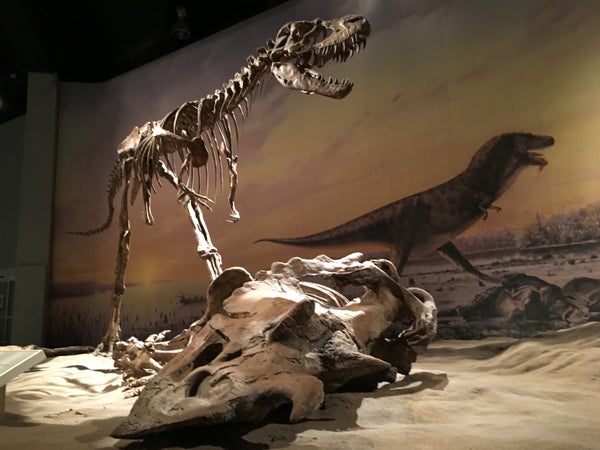This article was published in Scientific American’s former blog network and reflects the views of the author, not necessarily those of Scientific American
Some of the most fascinating, and contentious, aspects of dinosaur life are the parts we can’t see. What I’m talking about are the soft tissues of animals like Tyrannosaurus and Triceratops - the muscles, organs, nerves, and other squishy bits that decayed away long ago. But the wonderful thing about dinosaur bones - dinosaur skeletons - is that they interacted with and supported many of the missing parts we’re so curious about. Know what to look for and clues about what rotted away can still be retrieved. As Robert Brocklehurst, Emma Schachner, and William Sellers point out in a new study, it’s just this kind of anatomical outline that can tell us a little more about non-avian dinosaur lungs.
Before getting to the ancient bones, however, it’s best to start with the present. Birds are living dinosaurs, and we know that they have fantastically complex respiratory systems that involve a system of air sacs as well as lungs and a windpipe. These anatomical balloons often invade and indent bone, and it’s exactly this kind of coordination between bodily systems that has allowed paleontologists to identify air sac systems in saurischian dinosaurs (that is, the family that includes theropods like Velociraptor and sauropods such as Apatosaurus). But what about the lungs themselves? Did non-avian dinosaurs have lungs similar to those of modern birds, or does the avian lung have a more recent evolutionary origin?
Here, once again, the present is the key to the past. The researchers studied the pulmonary and surrounding skeletal anatomy of birds and crocodylians with an eye to how the soft and osteological tissues are influenced by each other, and this dataset was compared to skeletal details of non-avian dinosaurs and the protodinosaur Silesaurus. If the anatomy of vertebrae of birds and crocodiles is related to lung anatomy in birds and crocodylians, in other words, then that anatomical connection should allow the lung anatomy of extinct dinosaurs to be reconstructed.
On supporting science journalism
If you're enjoying this article, consider supporting our award-winning journalism by subscribing. By purchasing a subscription you are helping to ensure the future of impactful stories about the discoveries and ideas shaping our world today.
As might be expected given their different modes of life and over 235 million years of separate evolutionary trajectories, bird and crocodile lung anatomy differed significantly. This is a useful finding, given that non-avian dinosaurs could then be categorized as more crocodile-like or as more bird-like in pulmonary anatomy. And what the researchers found was that all the non-avian dinosaurs in the study, as well as Silesaurus, had vertebrae that created a “furrowed” ceiling of the thorax and is associated with a more bird-like lung that’s immobile along the top surface. All dinosaurs had lungs that were more bird-like than crocodile-like.
This doesn’t mean that all dinosaurs were just big birds. (Very non-bird like dinosaurs like Triceratops were part of this study, as well as those closely related to the origin of birds.) Rather, as the anatomists point out, the results indicate that the ancestral condition for dinosaurs was “a dorsally immobile lung, strongly partitioned into gas-exchanging and ventilatory regions.” Modifications from that basic setup - perhaps kept conservative in ornithischian dinosaurs and highly modified with air sac systems in saurischians - allowed for the respiratory diversity that paleontologists are now assessing and studying.
And this might have something to do with the origin of dinosaurs themselves. The physiological consequences of having more bird-like lungs likely made non-avian dinosaurs more efficient at taking up oxygen from the air than other vertebrates, Brocklehurst and colleagues write, an advantage when atmospheric oxygen levels sometimes dropped. Dinosaur lung anatomy may have given them a significant survival advantage, and perhaps could be a key to why the “terrible lizards” emerged triumphant to rule the world through the Jurassic and Cretaceous.
